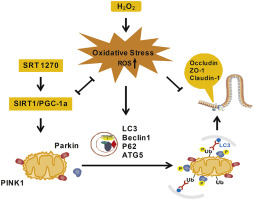Our official English website, www.x-mol.net, welcomes your
feedback! (Note: you will need to create a separate account there.)
SIRT1/PGC-1 pathway activation triggers autophagy/mitophagy and attenuates oxidative damage in intestinal epithelial cells.
Biochimie ( IF 3.3 ) Pub Date : 2019-12-09 , DOI: 10.1016/j.biochi.2019.12.001 Danyang Liang 1 , Yisha Zhuo 1 , Zeheng Guo 1 , Lihua He 1 , Xueyi Wang 1 , Yulong He 1 , Lexing Li 1 , Hanchuan Dai 1
Biochimie ( IF 3.3 ) Pub Date : 2019-12-09 , DOI: 10.1016/j.biochi.2019.12.001 Danyang Liang 1 , Yisha Zhuo 1 , Zeheng Guo 1 , Lihua He 1 , Xueyi Wang 1 , Yulong He 1 , Lexing Li 1 , Hanchuan Dai 1
Affiliation

|
Oxidative stress leads to intestinal epithelial cells damage, which induces tight junction injury and systemic endogenous stress syndrome. The evidence suggests that SIRT1/PGC-1α pathway is closely associated with oxidative damage. However, the mechanism in protecting intestinal epithelial cells against oxidative stress dependant on autopahgy/mitophagy remains to be elucidated. In the current study, we investigated the functional role of SIRT1/PGC-1α pathway on regulation of autopahgy/mitophagy and tight junction protein expression underlying the oxidative dysfunction in porcine intestinal epithelial cells (IPEC-1). Results demonstrated that H2O2 exposure caused high accumulation of ROS, with a decrease of mitochondrial membrane potential and an inhibition of the tight junction molecules in IPEC-1 cells. Also, COX IV mRNA expression and SIRT1/PGC-1α pathway were suppressed. Autophagy and PINK1/Parkin dependant-mitophagy were activated following H2O2 treatment. Further research indicated that activation of SIRT1/PGC-1α pathway caused by specific activator SRT 1720 resulted in elevating autophagy/mitophagy related markers and SIRT1 inhibitor EX 527 reversed these effects. Additionally, SIRT1 activation significantly suppressed the ROS generation, leading to increase mitochondrial membrane potential and COX IV expression. Most importantly, the expression of tight junction molecules contributing to maintain intestinal barrier integrity was significantly up-regulated. Collectively, these findings indicated that autophagy/mitophagy elevation caused by SIRT1/PGC-1α pathway activation might be a protective mechanism to increase tight junction integrity against oxidative stress-mediated ROS production in IPEC-1 cells.
中文翻译:

SIRT1 / PGC-1途径的激活触发自噬/有丝分裂,并减弱肠上皮细胞的氧化损伤。
氧化应激导致肠上皮细胞损伤,从而引起紧密连接损伤和全身性内源性应激综合症。有证据表明SIRT1 /PGC-1α途径与氧化损伤密切相关。然而,保护肠上皮细胞免受依赖于自噬/有丝分裂的氧化应激的机制仍有待阐明。在当前的研究中,我们调查了SIRT1 /PGC-1α通路在调节猪肠道上皮细胞(IPEC-1)氧化功能障碍的自噬/有丝分裂和紧密连接蛋白表达中的功能。结果表明,H2O2暴露引起ROS的大量积累,线粒体膜电位降低,并抑制IPEC-1细胞中的紧密连接分子。还,COX IV mRNA表达和SIRT1 /PGC-1α途径受到抑制。H2O2处理后激活了自噬和PINK1 / Parkin依赖性有丝分裂。进一步的研究表明,由特异性激活剂SRT 1720引起的SIRT1 /PGC-1α途径的激活导致自噬/有丝分裂相关标志物升高,SIRT1抑制剂EX 527逆转了这些作用。此外,SIRT1激活显着抑制了ROS的产生,从而导致线粒体膜电位和COX IV表达的增加。最重要的是,有助于维持肠屏障完整性的紧密连接分子的表达明显上调。总的来说,
更新日期:2019-12-09
中文翻译:

SIRT1 / PGC-1途径的激活触发自噬/有丝分裂,并减弱肠上皮细胞的氧化损伤。
氧化应激导致肠上皮细胞损伤,从而引起紧密连接损伤和全身性内源性应激综合症。有证据表明SIRT1 /PGC-1α途径与氧化损伤密切相关。然而,保护肠上皮细胞免受依赖于自噬/有丝分裂的氧化应激的机制仍有待阐明。在当前的研究中,我们调查了SIRT1 /PGC-1α通路在调节猪肠道上皮细胞(IPEC-1)氧化功能障碍的自噬/有丝分裂和紧密连接蛋白表达中的功能。结果表明,H2O2暴露引起ROS的大量积累,线粒体膜电位降低,并抑制IPEC-1细胞中的紧密连接分子。还,COX IV mRNA表达和SIRT1 /PGC-1α途径受到抑制。H2O2处理后激活了自噬和PINK1 / Parkin依赖性有丝分裂。进一步的研究表明,由特异性激活剂SRT 1720引起的SIRT1 /PGC-1α途径的激活导致自噬/有丝分裂相关标志物升高,SIRT1抑制剂EX 527逆转了这些作用。此外,SIRT1激活显着抑制了ROS的产生,从而导致线粒体膜电位和COX IV表达的增加。最重要的是,有助于维持肠屏障完整性的紧密连接分子的表达明显上调。总的来说,











































 京公网安备 11010802027423号
京公网安备 11010802027423号